|
Masako Ando was born in 1976 and is a currently active
painter. Some may say that her style resembles Antonio Lopez in Spain
realism. She makes only pencil drawings or oil paintings. The motif of
her paintings are living creatures such as children, animals, insects, and
flowers. She depicts this phenomenon with precision by observing such
motifs finely every corner. She carefully draws these motifs with the same
level of concentration. Therefore, when we see her work, we find it
difficult to grasp all the pieces. In her work, all existence is
equivalent. In pencil drawing, she pays hard labor to pull
each line and fix it on the screen. In oil painting, she puts the paint on
the canvas, strikes thinly with a brush or palm, stretches it, repeats
polishing with sandpaper. As a result, she finishes the canvas like a
porcelain to a smooth surface. The texture of the motif that she expresses
with outstanding descriptive power will have an amazing reality. Besides,
she polishes the surface of the screen, erasing brush strokes and
substance feeling of the paint. When we look at her paintings, we not only
are surprised by realistic depictions but also feel fictionality that does
not have a presence as a substance. We wander to fumble between reality
and fiction.
One day the Homoi of the rabbit child helps the child of the
lark drowning in the river, and as a thankful thanks to him the parent of
the lark will be handed the "Kainohi" called "the gift from our king".
According to Homoi's father, this "Kainohi" is a treasure that there are
only two people in birds and one in fish so far who have passed through
for the rest of my life, my father takes care of homoeys and does not lose
the light I will admonish you. The next day, the homoei who went outside gets puzzled as it
gets a great respect from the animals we met. Homoi's mother told that it
was because homoei became splendid. Homoi, who became happy to know that
he became a "great ", will begin to order various animals around him from
the next day. Meanwhile, by chance I saw that a fox who had been meaningful
to himself up to himself lowered his head to himself, Homoi made him his
own family, but the fox soon began to take it into homoei, and Haimoi
himself I gradually become proud of it. The father who saw the appearance
of such a homoea advises "Be careful of fox", but still the homoei is
likely to get on the word of the fox at
times. When the attitude of the fox gradually became honorable, when
the homoea was threatened by the fox and participated in the wrong,
"Kainohi" began to turn muddy, until the fire in the gem disappears at
last. Homoi and his father stop the fox 's plot, but "Kainohi" broke, and
Homoy became blind. My father said such a homoei "There is such a thing
anywhere, you are most fortunate, you are fortunate, my eyes will surely
improve again because my dad will do it well." She produced a "The Garden of Belly Buttom" in both pencil drawings and oil paintings. First, let's see a pencil drawing. It is a simple motif that an infant who puts out a navel in the field stands. I was fascinated by the pencil drawing. Every one of the extremely fine lines that she draws with a pencil is delicate. She sometimes entangled its delicate lines, sometimes aligned, sometimes shading gently. I can see various images like fantasy, dynamic, meditative and lyrical by looking at the drawn line. In particular, these effects are expressed intensively in depictions of hair disturbed by combs and combs of infants. The hair of an infant is carefully drawn one by one hair that the soft, thin hair inherent in an infant is disturbed by a cloth with curly hair. It is fine and relentless anyway. I marveled at tremendousness, imagining how much labor and time she spent drawing this. Actually, she draws one drawing line, repeats applying various treatments such as scraping with sand paper. In other words, it's not just drawing lines. She is inclining her soul to a single line. But we casually look at the line, I do not notice that. The entire drawing is a natural body, traces of power are not noticeable. What is common to children, plants, birds and small animals she uses as a motif is a soft fabric. Those motifs are best suited to make use of the textured, precise lines drawn by her. Besides, this pencil drawing is composed of delicate lines
minutely drawn, and elements other than the drawing of a softly drawn
child appear in front of us. I feel eerie when I gaze at the drawing. For
example, an infant's eyes. The infant's eyes are empty. She draws the eyes
of an infant relentlessly and finely up to the glow. However, the more she
draws it, the more white spots become prominent to say white eyes. I can
not feel the vivid life feeling in the eyes of this infant. It makes me
feel like I'm watching the anatomical specimen of my eyes. Also, the pose
of an infant is adorable, but I can not feel the movement of the infant
drawn. The figure depicted by this young child seems to be something like
an insect specimen whose pose is fixed. So, it should be a lovely, warm
hearted motif, but the impression of seeing the figure drawn is cold and
eerie. Furthermore, let's move our line of sight to the periphery.
Various flowers are drawn at the foot of an infant. Some of these flowers
are eaten by insects, some are stolen by aphids, some are withered, it is
not only pretty, never celebrating. She expresses the beautiful and bad
appearance of the flower equivalently at the foot of an infant. Here, her
gaze is looking at both sides of the beauty and frankness of flowers at
the same time. I think this is the case for the entire drawing. The
infant's eyes are empty, even for young children full of life feeling soon
after they were born, she will see the shadow of death. And when she draws
an infant, she expresses its neighboring
sides. Therefore, I am concerned about the instability which lacks balance somewhere that the existence of the line which first mentioned as the feature of the work concerning this drawing is excessive, on the other hand there is emptiness as a whole I feel impressive.
As
mentioned above, she creates a painting with a great deal of time and
effort. Therefore, she is a poor work. Since I mentioned it carefully
in "The Garden of Belly
Buttom" , let's look at other works easily.
I wrote that, now she is going to the world that surged through reality. I think that it is because her excessive expression breaks the balance of reality that seemingly seems peaceful. To that, I do not think that she is conscious. Perhaps I think that she draws as I see it. Let's see the painting "Sphinx". I want you to see the girl's hair. The hair that is neatly aligned shines glittering like a mirror. She draws the girl's hair carefully. When we see the hair of each one she draws it appears as a smooth and glowing mirror surface. Even just watching the hair of a girl, I get fascinated by this work. It can be said that the depiction of a girl's hair is excessive. But that is her painting. She was obliged to do so. Also, I want the girl's hands, especially the fingers, to be seen. I think that the size of the fingers of the hand is unbalanced. It is too big for girls' fingers. In addition, the wrinkle of a girl's fingers. And she drew a lot of fingers hair. This finger seems to be a finger of a mature man. As I mentioned earlier, I think that she is drawn as it is being watched. She is looking at a girl like that. Also, I think that her consciousness as a painter feels something that can not be satisfied simply by softly drawing a child with soft skin with fluffy.
|
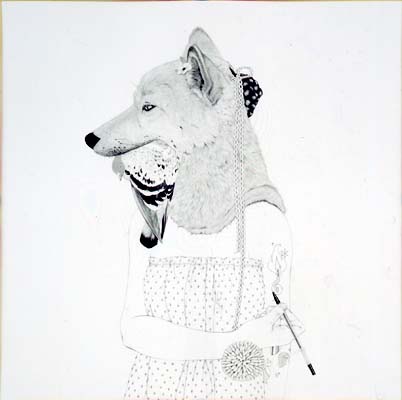

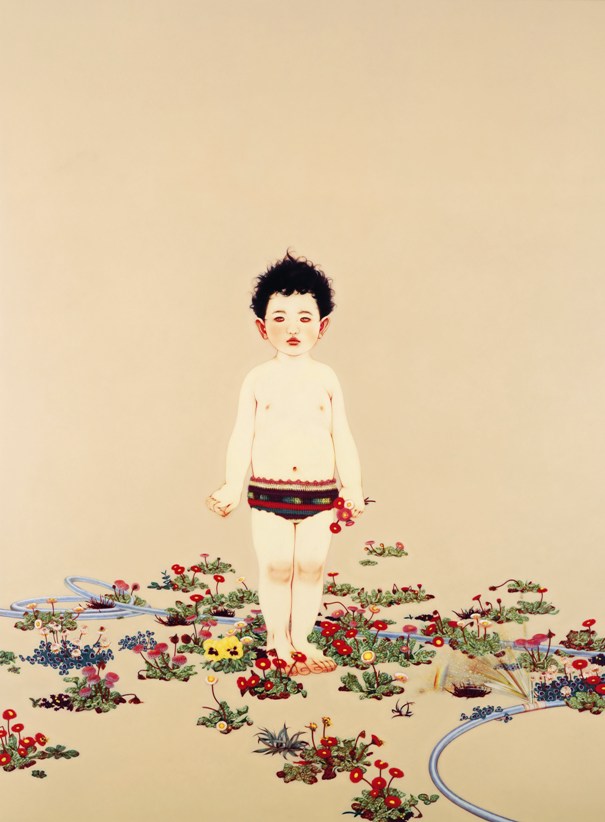
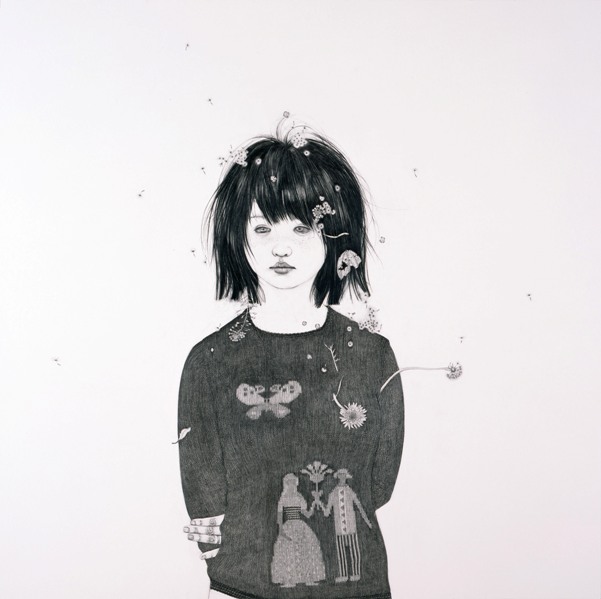
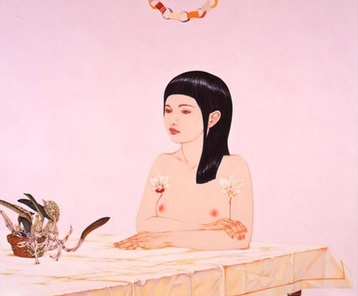
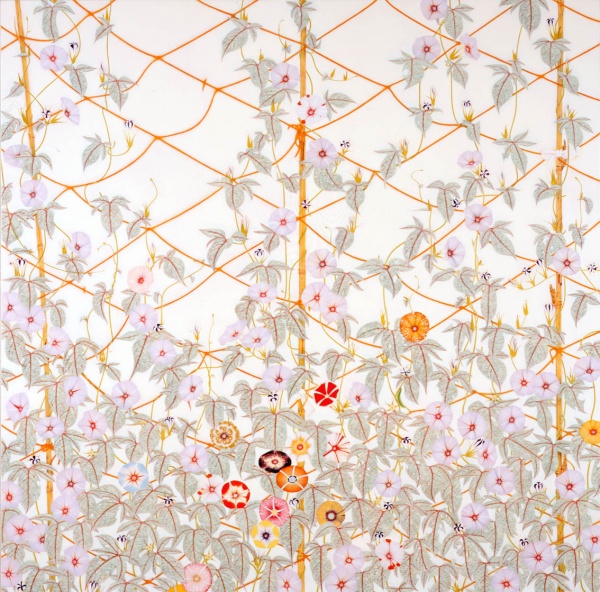
 Let's look
at oil painting
Let's look
at oil painting 